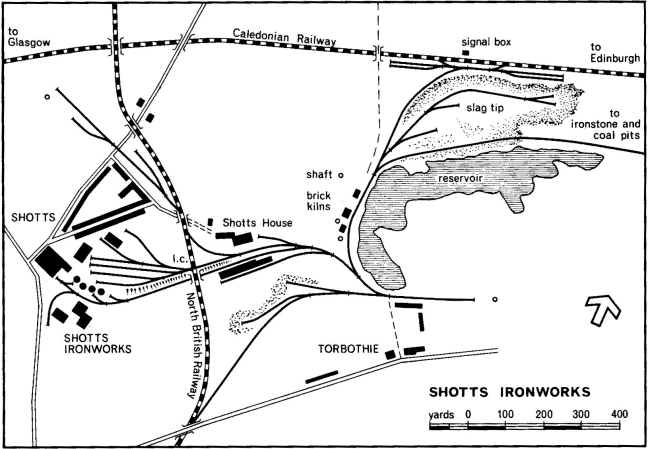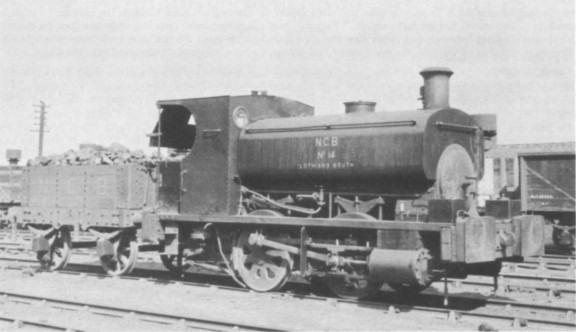
| THE INDUSTRIAL RAILWAY RECORD |
© JUNE 1973 |
AN ALARMING COLLISION AT SHOTTS
W. A. C. SMITH
An ironworks was established at Shotts in Lanarkshire as early as 1802. In 1869 when the Caledonian Railway completed their line from Glasgow to Edinburgh via Cleland and Midcalder a connection was made 43 chains east of Shotts station and about 1¾ miles short of Benhar summit. A signal box was established here on the north side of the line (which is straight at this point), the sidings opposite being joined from the south-west by a curved and sharply rising branch 35 chains in length from the ironworks which was reached by a back-shunt. There was a signal at the entrance to the sidings from the branch, controlled from the box, but no special rules were laid down by the Shotts Iron Company for working over their line excepting that drivers were instructed "to run cautiously and at low speed". By the beginning of 1887 the ironworks had, according to William Love, furnace manager, a fleet of five engines, "four of which work by day, and there is a driver, fireman, and breaksman (sic) attached to each". They worked as required both to the Caledonian sidings and to the slag-hill, the drivers getting their orders every morning from the foreman.
On the very foggy morning of Tuesday, 4th January 1887, driver John Leddy, who had started with the Company as a brakesman and had been driving for two years, had his regular engine, No.5, "a four-wheel coupled pug engine". After doing some work on the bank he took 14 or 15 empty wagons up to the Caley connection and left them in No.1 east siding next the main line. Shortly after nine o'clock he set off back to the works accompanied by fireman John McCallum, his brakesman having gone for breakfast. Although visibility was poor he did not sound his whistle. "We generally whistle when we have a train on in thick weather, but not when running light, as there is not then so much noise, and we can more easily hear another engine coming." His headlamp was burning but was at the back as the engine was running footplate first. Just after passing a brick kiln he saw a train coming up and was in the act of reversing his engine when they collided. He was thrown against the coal box by the impact and then off the footplate. As he struggled to his feet he saw No.5 in reverse gear and with steam on starting off back towards the sidings. "I tried to catch it ... but could not go fast enough." Fireman McCallum had been standing with one foot on the left hand step looking forward, but never saw the approaching train until the collision took place when he was thrown to the side of the line. By the time he had got up the runaway had disappeared into the fog.

The driver of the other train, Alexander Ingles, had been employed as a driver for only three months. He had No.6 ("a similar engine to No.5") and was hauling from the furnaces four small slag bogies said to measure 6 feet overall. Once out of the works he reversed No.6 so that he could propel the bogies up to the "hill". His fireman, one Thomas Burgess who had been a locomotive man at the Calder Ironworks until the previous year, was riding at the front of the engine. "The fireman always rides there when we are pushing slag waggons, so that he may see if any slag falls off." They had gone about 120
yards when, he. saw No.5. It was then only two or three yards off his train. He immediately called to his driver to stop but as the speed was only about 3mph Ingles was not at first aware that a collision had occurred.James Mathers, signalman at the Shotts Ironworks box for 12½ years, had come on duty at 6am for his usual 12 hour shift. At 9.09am he accepted the 8.25am express from Edinburgh to Glasgow (Central) and lowered his signals for it. As he heard it approaching he also heard an engine coming from the ironworks, the unusual noise of which attracted his attention. He was unable to see it until it was opposite the box and then, perceiving that it was unattended, he threw his signals to danger. A few seconds later Conner 2−4−0 No.475 with nine six−wheel coaches passed with steam shut off and the Westinghouse brake fully applied. After wiring Shotts station for assistance, fearing that "something bad might have resulted", Mathers went down to the sidings. A Caledonian wagon examiner had been inspecting the wagons brought up by No.5 when without warning the rear three (all Caledonian vehicles) were thrown off the rails. The end one landed across the down main line with the end of the next also fouling the running line. Just after this he heard the passenger train coming and saw it demolish the wagon across the track while the other scraped along the entire length of the train. Going to the Shotts engine he found it derailed, but with the regulator fully open. "Some one came down and shut off steam."
Despite the fog which made him 3 minutes late away from West Calder, everything went right that morning for David Clark, driver of the passenger train and 30 years in the service, until he was approaching Shotts Ironworks box at about 35mph with the distant off. When the home signal came into sight at some 20 yards distance it was at danger, so he made a full brake application. The wheels skidded on the frosty rails and when the train came to a stand after about 400 yards he found a piece of wagon on the buffer beam. Going back he encountered the guard who, on hearing the sound of breaking glass, had jumped from his seat in the Bucket. This was just as well for him as it was found that nearly every window down the left hand side of the train had been smashed, and door handles, panelling and footboards damaged. Seven passengers were cut about the head and face, one gentleman "rather badly". Damage to No.475 was confined to the front spring and left hand steps which were torn away together with the front brake pipe. The train was taken forward to Shotts station and continued to Glasgow after about an hour's delay, the line being cleared by noon.
The "Glasgow Herald" in reporting this "alarming collision" delicately described the Shotts Ironworks engine as having become "unmanageable". Major F.A. Marindin, who conducted the Board of Trade Railway Accident Inquiry, found that "the servants of the Caledonian Railway Company are in no way responsible... The Board of Trade having no control whatever over the working on private mineral branches, it does not lie within my province to determine who, if anyone, is to blame for the collision on this branch, or to decide whether the driver of either engine was running at an injudicious speed, or whether the driver and fireman of No.5 engine fell or jumped off their engine; but it is perfectly clear that, for the safety of the public travelling on the main line, as well as that of the men working on the branch line, better regulations than those now in force are required". He went on to recommend that in foggy weather drivers should sound their whistles and that proper head lamps should be carried. "It would also be wiser to prevent engines from running in opposite directions on the same portion of single lines when they cannot see 20 yards ahead of them. I trust that the Shotts Iron Company, and other companies in a similar position, will take warning from this accident, and revise their regulations, before a worse one occurs." He felt, however, that the Caledonian had a lesson to learn regarding sidings close to running lines where the hard points "should lie in their normal position for the siding farthest from the main line". Major Marindin would have preferred interlocking of all points and signals from the box, but admitted such an arrangement as "very unusual".

None of the early locomotives at Shotts have a running number quoted for them in Society records, but presumably the No.5 and No.6 mentioned in the article are two of the following: Neilson 'tank locomotives' 346 of 1857 and 484 of 1859, Barclay 0−4−0 saddle tanks 76, 130, 143 and 173 of 1868, 1872, 1873 and 1875 respectively. NCB No.14 depicted here was photographed in 1952 by Frank Jones at Ramsay Pit, Loanhead, Midlothian; it was formerly Shotts No.6 and was built (or rebuilt?) at Shotts in 1909. It possesses several features found on early Barclay locomotives and further details
There remained the problem of claims arising from the accident. During February 1887 the Caledonian Board rejected a suggestion from the Secretary of the Shotts Iron Company that the Caledonian should settle such claims with adjustment later, and made a counter proposal that the Shotts Company should meet the claims. The Caledonian, "if and so far as any legal liability attaches to them, will acquiesce in such settlement as regards amount". In June the Shotts Company proposed that payments for injury to passengers (totalling £464.8.7) "be borne in the proportion two-thirds by them and one-third by the Caledonian". The latter, however declined liability for "damages to passengers" and continued to press their claim for loss to rolling stock. The last entry on the subject in the Minutes is dated 18th October 1887 and reads "Remit to Manager to settle".
John Leddy, described as a good, steady man, evidently survived in the employment of the Shotts Iron Company for, in the Caledonian Mineral Timetable of 1914, he appears as a driver in the list of private parties authorised to run engines over certain portions of the Caley system, in this case in the Shotts sidings.
The Ironworks eventually became a National Coal Board Workshops and as such was closed down in 1970. The signal box and sidings (also the former North British connection) were removed some years ago.
Sources:- Board of Trade Railway Accident Report, Caledonian Railway Board and Committee Minutes, Caledonian Railway Working Timetable and Appendix thereto, and the "Glasgow Herald" : Acknowledgements are made to the National Library of Scotland and the Scottish Record Office, Edinburgh, and the Mitchell Library, Glasgow, for access to certain of this material.